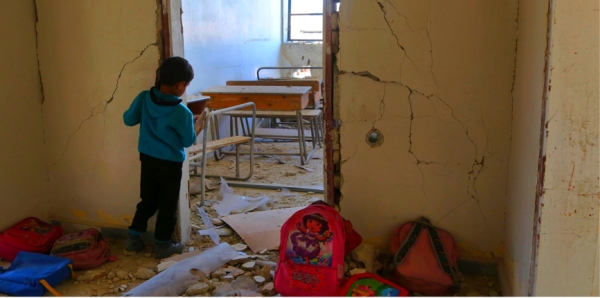In its latest report, the Global Coalition to Protect Education from Attack (GCPEA) , founded in 2010 by organizations working in the fields of education in emergencies and conflict-affected contexts, documents attacks on educational facilities in situations of insecurity and armed conflict. The coalition includes: Save the Children, the Office of the United Nations High Commissioner for Refugees (UNHCR), the United Nations Children’s Fund (UNICEF), the Council for At-Risk Academics (CARA), and Human Rights Watch.
Covering the period January 2017 to December 2019, the study documents the devastating effects of attacks on educational institutions on human lives and long-term peace in 37 countries. The report tracks five types of attacks against and military use of educational facilities: attacks on schools; attacks on students and educational personnel; military use of schools and universities; child recruitment at, or on the way to school; sexual violence at, or on the way to or from, school or university; and attacks on higher educational facilities.
Attack on educational facilities, which can take various forms, is usually carried out for military, political, ethnic, religious or ideological reasons. In some cases, attackers use explosive devices or arms to destroy facilities, while in other cases, they target students or faculty. Moreover, armed forces, other state security entities and non-state armed groups use schools for military purposes even while children are present in them. In endemic conflict zones, schools and universities are even subjected to repeated attacks. This violence against educational facilities also has other effects, including effects on mental and physical health such as trauma, health complications, fear or anxiety, which could hinder students’ abilities to continue studying.
GCPEA has documented over 11,000 attacks on educational facilities and their use by the military, harming at least 22,000 school and university students, teachers, professors, and other personnel. During the reporting period, Afghanistan, India, and Palestine had the highest reported numbers of persons harmed by such attacks. The report finds that Yemen and the Democratic Republic of the Congo (DRC) were most affected by attacks on schools. In Yemen, ground strikes, airstrikes and gunfire destroyed or damaged schools, particularly in the Taizz and al-Hudaydah governorates; in DRC, schools in Ituri and Tanganyika provinces experienced hundreds of attacks by armed groups. In Afghanistan, over 100 schools were targeted with explosive devices and arson while being used as polling stations. 40 percent of the schools in Syria were destroyed or partially damaged by fighting. In Western African countries, including Burkina Faso, Mali and Niger, thousands of schools have been forced to close due to violence spread by armed groups.
GCPEA also highlights that armed forces and non-state armed actors sexually violate female students and teachers. Sexual assaults can occur during, or in the aftermath of attacks on schools. The study lists 15 countries where such attacks are prevalent: Afghanistan, Burundi, Colombia, DRC, Egypt, Iraq, Myanmar, Nicaragua, Nigeria, the Philippines, Somalia, South Sudan, Sudan, Venezuela, and Yemen. However, data on sexual violence at, or on the way to or from, schools or universities remain difficult to collect due to the stigma surrounding sexual violence, preventing victims from reporting them. GCPEA conducted a deep examination of the gender dynamics of attacks against women and girls. In its findings stressed that these attacks usually take the form of sexual violence or repression of girl’s education. For instance, in Nigeria forced marriages of school girls with Boko Haram fighters prevented girls from attending school and completing their studies. Moreover, girls recruited by armed groups are less likely than boys to return to school after their laying down the arms as a result of “harmful social norms that made them feel ashamed or afraid to return to school”.
In its analysis of global trends of violence, the report constitutes that the levels of peace increased since 2018. Despite these improvements, security has deteriorated in 76 countries, which already face fragility and insecurity, such as Cameroon, Yemen, Mali and Venezuela. Moreover, the the number of verified incidents against children peaked in 2017 -however, this increase could be attributed to improvements in monitoring and reporting.
GCPEA recognized that, despite the progress made in protecting educational facilities from attacks, more remains to be done. It recommends to all countries to implement the Safe School Declaration, and to further improve monitoring and reporting attacks on educational facilities, including disaggregated data by: type of attack, sex, age, location, group responsibility, etc. The report also urges armed forces and armed groups to refrain from using schools and universities for military purposes, thus implementing the Guidelines for Protecting Schools and Universities from Military Use during Armed Conflict. Furthermore, GCPEA urges international judicial institutions to systematically investigate attacks on educational facilities and to prosecute those responsible.
To learn more, please read:
https://reliefweb.int/sites/reliefweb.int/files/resources/eua_2020_full.pdf
https://ucdp.uu.se/exploratory
https://ssd.protectingeducation.org/endorsement/
Author: Silvia Luminati







